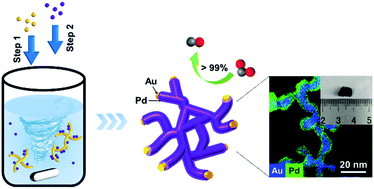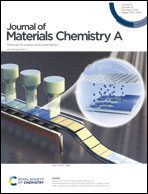Rapid synthesis of gold–palladium core–shell aerogels for selective and robust electrochemical CO2 reduction†
Abstract
Noble metal aerogels (NMAs), one class of the youngest members in the aerogel family, have drawn increasing attention in the last decade. Featuring the high catalytic activity of noble metals and a 3D self-supported porous network of the aerogels, they have displayed profound potential for electrocatalysis. However, considerable challenges reside in the rapid fabrication of NMAs with a well-tailored architecture, constraining the manipulation of their electrochemical properties for optimized performance. Here, a disturbance-assisted dynamic shelling strategy is developed, generating self-supported Au–Pd core–shell gels within 10 min. Based on suitable activation and desorption energies of the involved species as suggested by theoretical calculations, the Au–Pd core–shell aerogel manifests outstanding CO selectivity and stability at low overpotential (faradaic efficiency > 98% at −0.5 V vs. RHE over 12 hours) for the electrochemical CO2 reduction reaction (CO2RR). The present strategy offers a new perspective to facilely design architecture-specified high-performance electrocatalysts for the CO2RR.



 Please wait while we load your content...
Please wait while we load your content...